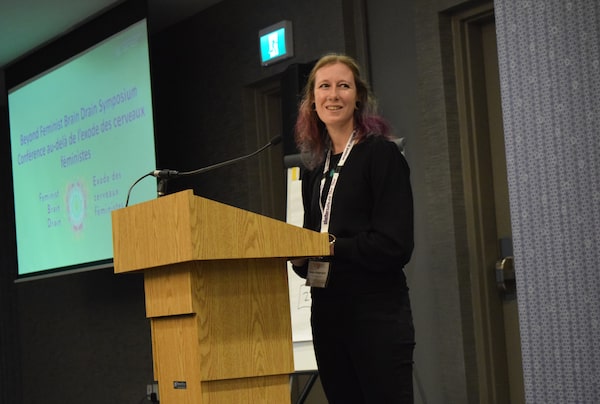
Robyn Hoogendam of Women's Shelters Canada speaks in Ottawa in a Nov. 9, 2022 in a handout photo.Kaitlin Geiger-Bardswich/The Canadian Press
Sparse, inadequate funding is driving a burnout crisis among staff at women’s shelters and transition homes across the country, says a report released Thursday by a national non-profit.
The “Feminist Brain Drain” report from Women’s Shelters Canada surveyed more than 300 shelter and transition house employees across the country. It shows shelters coping with high rates of staff turnover and overwhelming workloads while trying to maintain a patchwork of revenues from governments and donations.
Robyn Hoogendam, the group’s research and policy manager, said the COVID-19 pandemic and the housing crisis that followed have led to a rise in complicated cases involving severe violence, addiction and homelessness.
“There’s a crisis. And if we don’t find stable funding for these organizations, it’s going to put in jeopardy their ability to do this work,” Hoogendam said in an interview. “And this is life-saving work that these organizations do every day.”
The report found that 28 per cent of respondents said they were planning to find a new job in the next year. Nearly one-third, or 32 per cent, of respondents felt overwhelmed by their workload, with one-fifth reporting they had 20 clients or more.
Sixty-six per cent of respondents in non-managerial roles said they earn less than $50,000 a year, and nearly one-third said they had to work a second job to pay their bills.
Jodi McDavid is among those shelter workers with two jobs. She runs the Cape Breton Transition House Association in Nova Scotia, which includes a shelter, a small apartment complex and a rooming house, and she teaches part time at the local university.
She said her front-line staff make an average of $54,000 a year – about $30,000 less than what someone working for victims’ services with the provincial Justice Department earns. It’s nowhere near enough, she said.
“Everyone says, ‘OK, do self care,’ and a lot of responsibility is put on the individual, which I agree with,” McDavid said in an interview. “But at the same point, if we are not making adequate wages, how do you do that wellness? How do you have the money to go and do that? You can’t just go on a vacation.”
The numbers come nearly a year after publication of the final report from a public inquiry into the April 2020 Nova Scotia mass shooting, which began when the killer attacked his common-law spouse. He killed 22 people, including a pregnant woman, over the course of 13 hours before he was shot dead by police.
The inquiry’s report said intimate partner violence should be declared a public health emergency, and it called for stable funding for organizations working to prevent it. That funding recommendation is echoed in the Women’s Shelters Canada report.
The report also highlights the COVID-19 pandemic, which Hoogendam said had a profound impact on shelters. Women emerged from lockdowns having faced more violent attacks – and more severe violence – than before, she said. The pandemic also led to an increase in cases requiring mental health and addictions support, she added.
The rise in complex cases puts more demand on shelters, and that pressure hasn’t let up, she said. The housing and affordability crisis is also making it difficult to find clients housing, and more expensive to care for them.
Fundraising adds to increased workloads, requiring shelter directors and staff to submit lengthy applications to various levels of government several times a year, as well as regular reports about how money is spent. The work is consuming resources and depleting morale, and the government money isn’t enough to keep up with inflation, shelter demand or salary needs, she said.
For McDavid in Nova Scotia, there is some hope. The provincial government included a $7.1-million boost to core funding for women’s shelters and transition homes in its budget last week. It’s the first significant increase in a decade, said Ann de Ste Croix, the provincial co-ordinator of Nova Scotia’s Transition House Association.
The extra money is certainly welcome, and will bring some much-needed change, said de Ste Croix and McDavid. But more permanent, stable money is still needed to address the low wages, staff burnout and escalating needs in the province’s shelter systems, they said.
“There’s still a long way to go,” McDavid said.